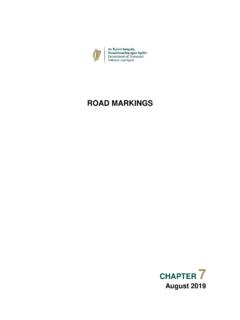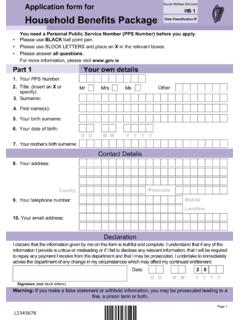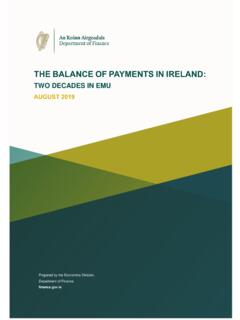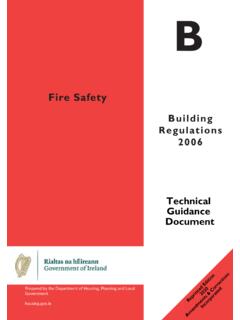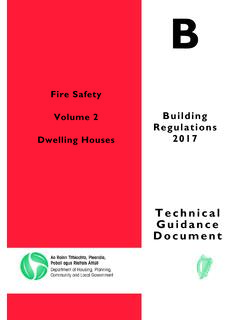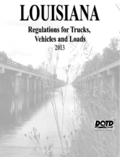Transcription of 7. Road Markings
1 7. Road Markings CHAPTER 7 November 2010 7/1 Traffic Signs Manual Chapter 7 Road Markings Contents Introduction .. 7/3 Page General .. 7/3 The Function of Road Markings .. 7/3 Classes of Marking .. 7/4 Speed .. 7/5 Legal .. 7/5 Materials .. 7/5 Transverse 7/6 Stop Line (RRM 017) .. 7/6 Tram Stop Line (RRM 031) .. 7/8 Yield Line (RRM 018) .. 7/8 No Entry Line (RRM 019) .. 7/9 Longitudinal Markings .. 7/12 Centre Line Markings .. 7/13 Climbing / Overtaking Lanes .. 7/19 Right-Turn Lanes .. 7/21 Passing Lanes on Type 3 Dual Carriageways .. 7/21 Lane Lines (RRM 003) .. 7/22 Merge/Diverge Lane Line (RRM 028) .. 7/23 Edge of Carriageway Lines (RRM 025, RRM 026 & RRM 027) .. 7/24 Raised Profile Edge 7/25 Hatched Markings .. 7/29 Motorways and High Quality Dual Carriageways .. 7/30 Other Roads .. 7/32 Worded and Diagrammatic Markings .. 7/36 Stop (M 114).
2 7/36 Triangular Yield Marking (M 115) .. 7/36 Slow (M 106) .. 7/37 Look Left/Right (M 107L/R) .. 7/37 Arrows .. 7/38 Lane Destination Markings (M 105) .. 7/42 School Keep Clear Marking (RRM 010) .. 7/44 School Warden crossing Patrol Point (M 121) .. 7/45 Speed Markings (M 108) .. 7/46 Emergency Telephone and Chainage Markings (M 120) .. 7/47 November 2010 7/2 Parking Restrictions and Parking Bays .. 7/48 Parking Restrictions .. 7/48 Parking Bays .. 7/49 Taxi Stand (RRM 029) .. 7/51 Loading Bay (RRM 009) .. 7/52 Bus and Tram Markings .. 7/53 Bus Stop (RRM 030) .. 7/53 Bus Lanes .. 7/55 Tram Lanes .. 7/60 Cycle Tracks .. 7/62 With-Flow Cycle Tracks .. 7/62 Contra-Flow Cycle Tracks .. 7/64 Cycle Tracks Not On The Carriageway .. 7/64 Yellow Box 7/66 Reflecting Road Studs .. 7/68 Priority Junctions .. 7/71 Ghost Island Junctions .. 7/75 Right-Turn Junctions on Dual Carriageways .. 7/75 Signal Controlled Junctions.
3 7/79 Roundabouts .. 7/81 Normal Roundabouts .. 7/81 Mini-Roundabouts, RRM 7/86 Grade-Separated Junctions .. 7/88 Level Crossings .. 7/90 pedestrian Crossings .. 7/92 Zebra crossing (RPC 001) .. 7/92 Signalised pedestrian crossing .. 7/93 Zig-Zag Markings (RPC 002) .. 7/94 Traffic Calming .. 7/98 Yellow Bar Markings .. 7/99 Appendix 7A: Lettering for Worded Markings .. 7/103 Appendix 7B: Airport, Ferry and Disabled Persons Symbols .. 7/109 Appendix 7C: Schedule of Road Markings .. 7/110 November 2010 7/3 Introduction GENERAL This Chapter provides details of the road Markings which may be used on roads in Ireland, including their layout and symbols, the circumstances in which each marking may be used and guidance on positioning them. The chapter should be read in conjunction with other relevant chapters. Further information on the use of the Manual is given in Chapter 1.
4 For the purposes of this Manual: Shall or must indicates that a particular requirement is mandatory; Should indicates a recommendation; and May indicates an option. The diagrams for each marking indicate any variants which are permitted. The standard dimensions for Markings are given on the diagrams or in the relevant tables in this chapter. Most road Markings are regulatory Markings which are referred to in the relevant legislation (see Chapter 1). Regulatory road Markings have numbers which are prefaced by RRM and RPC. Markings which are non-regulatory have numbers prefaced by the letter M. Where variations are allowed (such as in the case of centre line Markings ) suffix codes have been provided to assist designers and contractors to identify the variants. It should be noted that the suffices do not form part of the legal descriptions of the Markings .
5 It should be noted that Markings conforming to the previous designs will continue to have legal effect. However, all new or reapplied Markings should conform to the new designs. Certain regulatory Markings (such as Stop and Yield Lines and those relating to parking restrictions) are associated with regulatory signs. The latter are described in Chapter 5. THE FUNCTION OF ROAD Markings Road Markings may be defined as Markings on the surface of the road for the control, warning, guidance or information of road users. They may be used to supplement upright signs, or they may be used alone. Road Markings have the limitation that they may be obscured by snow, leaves or debris on the carriageway. Their conspicuity is impaired when wet or dirty and their durability depends largely on their exposure to traffic wear.
6 Nevertheless, they serve a very important function in conveying to drivers information and requirements which might not otherwise be possible by the use of upright signs. They have the advantage that they can often be seen when an upright sign is obscured and, unlike such signs, they can provide a continuing message to the moving driver. November 2010 7/4 The continued increase in the volume of traffic using the roads makes the extensive use of road Markings essential to ensure that full advantage is taken of the available road space. In particular, widespread use of lane Markings is desirable. Enhancing lane discipline adds to the safety of traffic, besides improving traffic flows. Road Markings should be considered in detail at design stage in respect of new or improved roads and junctions.
7 The Markings for existing roads are best considered on plan before the work is undertaken. CLASSES OF MARKING Road Markings may be classified as follows: a. Transverse Markings , which are at right-angles (or thereabouts) to the centre line of the carriageway; b. Longitudinal Markings (including double line systems); c. Hatched Markings ; d. Worded and diagrammatic Markings ; e. Markings indicating parking and loading requirements; f. Bus and tram Markings ; g. Cycle track Markings ; h. Yellow box Markings ; and i. Road studs. The various classifications are covered in this chapter in the above order in Sections to Sections to illustrate their application in specific circumstances. Markings used for traffic calming purposes are included in Section , and Section describes the use of transverse yellow bar Markings .
8 November 2010 7/5 SPEED Throughout this Chapter reference is made to the speed of traffic, for example to determine the appropriate dimension of line marking to be used, or to define the visibility requirements for a continuous line system. Wherever speed is mentioned, it shall be determined as follows: On new or improved roads, speed is the Design Speed, calculated in accordance with National Roads Authority Standard NRA TD 91 In the case of existing roads, speed is the speed limit, except when there is a significant difference between the speed limit and actual vehicle speeds, in which case: ; speed shall be the observed 85th percentile approach speed of private cars. This is the speed which is exceeded by only 15% of cars in dry weather and may be measured by accepted speed survey methods. LEGAL Traffic signs and road Markings are provided in accordance with signs regulations or directions of the Minister of Transport.
9 They may be laid only by or on behalf of the Road Authority. Markings with the prefix RRM or RPC are regulatory road Markings , and attention is drawn to the statutory requirement for the Road Authority to consult with the Commissioner or appropriate delegated officer in the Garda S och na where such Markings are being provided. Markings with the M prefix have no regulatory significance. Some road Markings indicate a legal requirement (for example the transverse Stop Line, or longitudinal parking restriction Markings ) and may be accompanied by regulatory signing as specified in Chapter 5. MATERIALS The specifications for road Markings , including materials, equipment and methods of application, are detailed in the DoELG Guidelines and Tender Documentation for Road Marking Materials2 , to which the provision of road Markings should conform.
10 1 National Roads Authority. NRA TD 9, Road Link Design. Part of the NRA Design Manual for Roads and Bridges. NRA, Dublin. 2 Department of the Environment and Local Government. Guidelines and Tender Documentation for Road Marking Materials. DoELG, Dublin. November 2010 7/6 Transverse Markings The prescribed transverse Markings comprise: Stop Line; Tram Stop Line; Yield Line; and No Entry Line. STOP LINE (RRM 017) A 200mm wide Stop Line, RRM 017 indicates the position in advance of which a vehicle must be brought to a complete halt. At signals for level crossings or for swing or lifting bridges, the Stop Line shall be 300mm wide (see Section ). RRM 017 Stop Line Note: A special width of 300mm shall be used for Stop Lines at level crossings and swing or lifting bridges.
